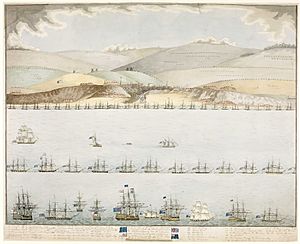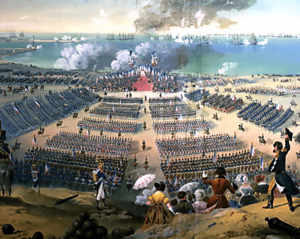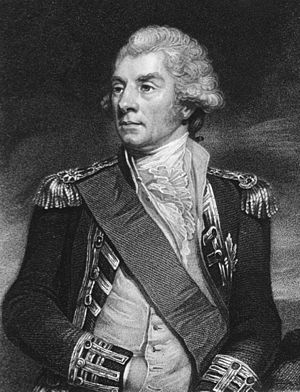Raid on Boulogne facts for kids
Quick facts for kids Raid on Boulogne |
|||||||
|---|---|---|---|---|---|---|---|
| Part of the Napoleonic Wars | |||||||
 Plan and key. The Attack on Boulogne Oct 1804, watercolour by E. D. Lewis (HMS Tartarus)) |
|||||||
|
|||||||
| Belligerents | |||||||
| Commanders and leaders | |||||||
| Casualties and losses | |||||||
| 1 ship lost | |||||||
The Raid on Boulogne in 1804 was a daring attack by the Royal Navy on the French port of Boulogne-sur-Mer. This event happened during the Napoleonic Wars. It was different from usual naval attacks because it used new inventions. These inventions came from an American inventor named Robert Fulton.
Even though the attack aimed high, it didn't do much damage to the French ships. But it might have made the French feel less confident. They were planning to cross the English Channel and invade Britain. This raid showed them how strong the Royal Navy was.
Contents
Why Attack Boulogne?
Napoleon's Invasion Plans
Napoleon chose Boulogne as a main starting point for his army. This army was called the Armée de l'Angleterre, meaning "Army of England." They were preparing to invade the United Kingdom.
For years, France had been building ships to carry soldiers across the Channel. These plans were paused for a short time by a peace treaty. But when fighting started again, Napoleon gathered his forces. He built huge military camps around Boulogne. The port was also made stronger for the invasion fleet.
Napoleon himself visited Boulogne in August 1804. He reviewed his troops and gave out medals. He believed his fleet only needed to control the Channel for six hours. Then, he thought, they could conquer the world.
Britain's Worries
The Royal Navy was Britain's main defense against this invasion. But British defenses on land were not ready. They were worried about an invasion force of over 100,000 men. If the French fleet could cross, London might be in danger.
British leaders knew where the French ships were gathering. The Royal Navy was closely watching these ports. However, Britain's navy chief, Lord Melville, didn't have enough ships. If French and Spanish fleets worked together, they might push the Royal Navy away. This could give Napoleon a chance to cross.
People in Britain were very worried. Important politicians suggested attacking the French ships in port. This would at least delay the invasion. Boulogne was very well protected. Previous attacks, like one led by Horatio Nelson in 1801, had failed. The French invasion barges were guarded by warships. Gun batteries on the cliffs also protected them. New ways to attack were needed.
New Ideas for Attack
Prime Minister William Pitt the Younger met with many inventors. They suggested new ways to attack the French. Some ideas included sinking ships to block the harbor. Others thought of sending balloons with rockets. There were also ideas for using fireships.
On July 20, 1804, Pitt met with Robert Fulton. Fulton was an American inventor. He had been working in France on submarines. But the French navy wasn't very interested. So, Fulton came to Britain and offered his help.
Fulton suggested an attack using fireships, torpedoes, and mines. These were all explosive devices. Pitt agreed to this plan. A deal was made, and Fulton began building his inventions. The goal was an attack later that year.
Getting Ready for the Raid
Napoleon left Boulogne on August 27. He went to Aachen to visit his wife, Joséphine. The British thought his departure might be a trick. They worried he would secretly return to lead the invasion.
Meanwhile, the British frigate HMS Immortalite surveyed the French coast. Captain Edward Owen led this mission. Soon, Fulton said his inventions were ready. The attack was planned for early October.
Fulton worked at Portsmouth Dockyard. He built several types of ships and explosives. One was the 'torpedo-catamaran'. This was a small, coffer-like device. It floated on two wooden pontoons. One man steered it with a paddle. It was weighted to sit low in the water. The operator wore dark clothes to hide. His job was to attach the torpedo to an enemy ship's anchor cable. Then he would activate it and escape before it exploded.
Many large barrels filled with gunpowder were also made. These would float with the tide. When they hit an enemy ship, they would explode. Several fireships were also part of the plan. They carried 40 barrels of gunpowder. A clockwork device would make them explode.
The British force gathered near Boulogne in late September. Lord Keith was in charge. He was on his flagship HMS Monarch. Lord Melville and Fulton were also there to watch.
Fulton had a deal: he would get £40,000 for the first ship destroyed. He would also get half the value of any other ship destroyed. This was on top of his £200 monthly salary. Lord Keith did not hide the British force. So, the French knew an attack was coming. By 9 PM on October 2, the wind and tide were right. The British ships began to move towards the harbor.
The Attack
The British ships approached in three groups. Gun-brigs escorted the fireships. Fulton's torpedo-catamarans, about 18 of them, also joined. The French had moved their frigates closer to shore. They also had a line of small boats called pinnaces for protection.
French guards quickly saw the approaching ships. They opened fire. The British crews on the fireships gave up on surprise. They steered straight ahead, set their explosive devices, and left their ships. The explosions looked amazing but didn't do much damage.
One fireship exploded between two French frigates. Another passed through the French line and blew up beyond it. One fireship was stopped by a French pinnace. Its crew boarded the fireship to search it. While they were doing this, it exploded. The French sailors and their pinnace were destroyed. This was the only real success of the night. Neither the torpedo-catamarans nor the exploding barrels worked well. The British kept fighting until 4 AM the next morning. Then, a strong wind forced them to find shelter.
What Happened Next
The British were disappointed with the results. Fulton said his machines were not used correctly. He started to improve them to make them easier to handle. Lord Keith, who had doubted the plan from the start, was understanding. He thought they had been unlucky. He believed another attempt might work better.
Lord Melville agreed. But he pointed out that the attack had a psychological effect. It caused panic among the French. The French then started building booms and chains across the harbor entrance. This would stop similar attacks in the future. This took time and made them focus on defense, not offense.
Winter weather arrived, so invasion plans were put off until spring 1805. Many British people made fun of the new devices. They thought it was an unfair way to fight. Fulton tried to use his devices again on September 19, 1805. This time, Sir Sidney Smith joined him. But again, the attack did not have much success.



